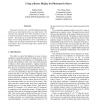109
click to vote
ECCV
2010
Springer
15 years 6 months ago
2010
Springer
Photometric stereo relies on inverting the image formation process, and doing this accurately requires reasoning about the visibility of light sources with respect to each image po...
87
Voted
ICCV
2005
IEEE
15 years 6 months ago
2005
IEEE
Photometric stereo is a fundamental approach in Computer Vision. At its core lies a set of image irradiance equations each taken with a different illumination. The vast majority o...
112
Voted
CAIP
2007
Springer
15 years 7 months ago
2007
Springer
This paper presents a novel shape recovery technique that combines photometric stereo with polarization information. First, a set of ambiguous surface normals are estimated from po...
CRV
2007
IEEE
15 years 7 months ago
2007
IEEE
This paper presents a new controlled lighting apparatus which uses a raster display device as a light source. The setup has the advantage over other alternatives in that it is rel...
113
Voted
CVPR
2010
IEEE
15 years 9 months ago
2010
IEEE
We present an imaging framework to acquire 3D surface scans at ultra high-resolutions (exceeding 600 samples per mm2 ). Our approach couples a standard structured-light setup and ...
115
Voted
CVPR
2010
IEEE
15 years 9 months ago
2010
IEEE
Modeling moving and deforming objects requires capturing as much information as possible during a very short time. When using off-the-shelf hardware, this often hinders the resolu...
105
Voted
CVPR
2010
IEEE
15 years 9 months ago
2010
IEEE
We present a self-calibrating photometric stereo method. From a set of images taken from a fixed viewpoint under different and unknown lighting conditions, our method automaticall...
102
Voted
ICPR
2008
IEEE
16 years 2 months ago
2008
IEEE
The objective of this work is classifying texture from a single image under unknown lighting conditions. The current and successful approach to this task is to treat it as a stati...
119
Voted
ECCV
2002
Springer
16 years 2 months ago
2002
Springer
Abstract. We introduce a new methodology for radiometric reconstruction from multiple images. It opens new possibilities because it allows simultaneous recovery of varying unknown ...
106
click to vote
ICCV
2005
IEEE
16 years 3 months ago
2005
IEEE
Virtually all structured light methods assume that the scene and the sources are immersed in pure air and that light is neither scattered nor absorbed. Recently, however, structur...






